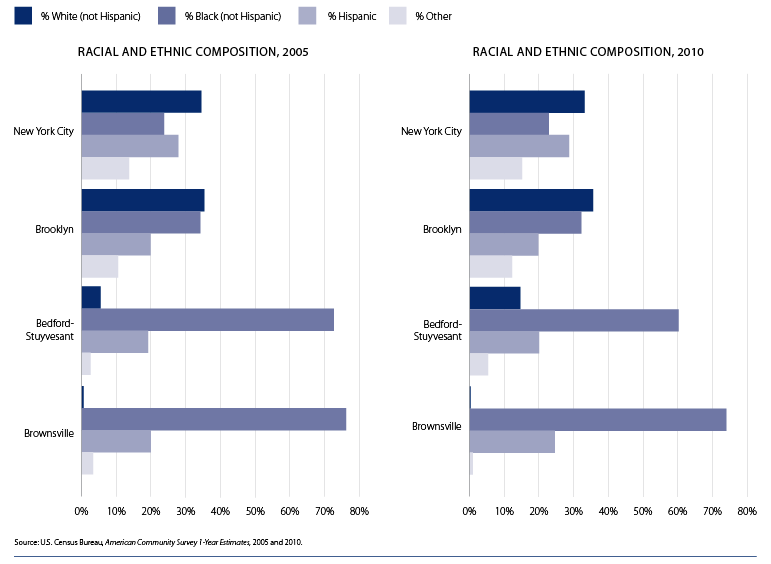a policy brief from ICPH
June 2013
In 2011, 12,422 families with children entered homeless shelters in New York City, a 17% increase since 2008.1 Reversing this trend will require that policymakers understand the factors that cause families to lose their housing. Unfortunately, the answer to why some families are able to subsist in a stable fashion, or sustain a kind of “poverty equilibrium,” while others experience homelessness has proved elusive to researchers and policymakers alike. The effort to understand the relationship between stable poverty and rising homelessness is not hindered by a lack of available information; public and private organizations spend thousands of dollars every year collecting data on homelessness in New York City. This report, the first of a series, uses this data on the changing demographics of New York City and takes a closer look at two neighborhoods in particular to examine the destabilizing factors affecting the experiences of at-risk families within them. Future ICPH reports will further explore these outcomes in neighborhoods across New York City.
In the period from 2005 to 2009, 49,403 families entered the Department of Homeless Services’ (DHS) shelter system.2 Of course, the need for shelter is not equal across the city. As seen in Figure 1, community districts in the South Bronx and central Brooklyn dominate the list of the highest-contributing areas, while comparatively few families in shelter come from Manhattan. This pattern may not seem surprising to those familiar with the demographics of New York City and its 59 community districts, but awareness of where shelter entrants are coming from, and how geographic trends shift over time, is key to understanding and ultimately addressing the multiple pathways leading to homelessness.
Figure 1
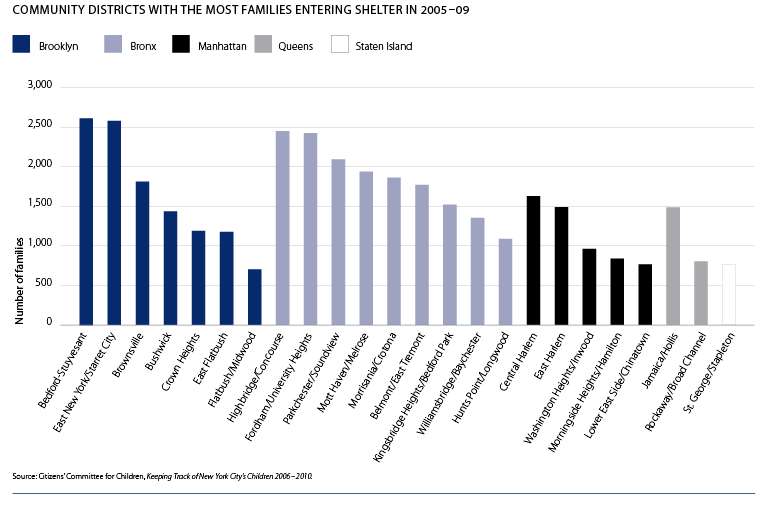
The abundance of Brooklyn and Bronx neighborhoods in Figure 1 points to the flaw in most investigations into the causes of local homelessness: the failure to acknowledge the socioeconomic diversity across the city. There are many reasons why a family may slip into homelessness, and these families’ stories can be lost when the problem is studied with too wide a focus. Many types of neighborhood-level changes occur that can either help or hinder a family as it struggles to maintain stable housing. Examples of these trends include gentrification and migration. As new residents move into a neighborhood, the housing market destabilizes and competition increases, and existing community members are often displaced into surrounding areas. The following section of this report examines the changing demographics of two adjacent Brooklyn neighborhoods, Bedford-Stuyvesant and Brownsville, to illustrate the type of explanation hidden in quantitative analysis.
Figure 2
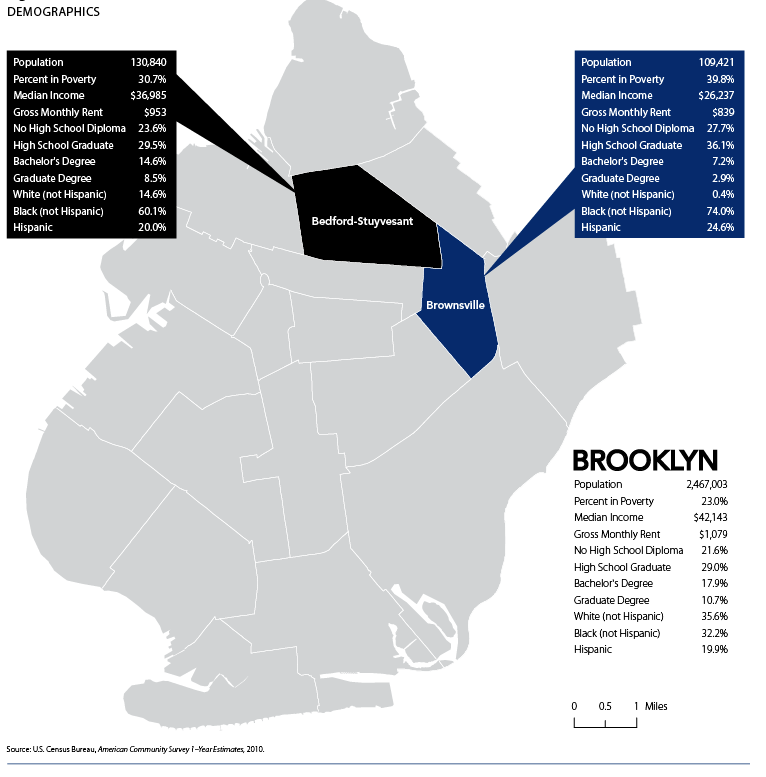
Figure 3
xxx
A Study in Contrasts: Bedford-Stuyvesant and Brownsville
At first glance, the differences between Bedford-Stuyvesant (Bed-Stuy) and Brownsville are puzzling. Because they are neighbors, one might expect some amount of uniformity across their economic indicators. To an extent, there is: both neighborhoods have a high rate of family homelessness. Bed-Stuy, however, saw the beginnings of gentrification in the five years under consideration, despite contributing 2,617 families to the shelter system from 2005 to 2009. Its neighbor to the east, Brownsville, is packed densely with housing projects and has been an area of concentrated poverty for its black and Hispanic residents for many years, with few improvements and, in some areas, declines. Brownsville also has a large number of families entering shelter—1,812 over the same period. By examining race, the influence of public housing, levels of education and income, and housing costs in these adjacent neighborhoods, it is possible to understand how localized gentrification can destabilize the balanced distribution of regional poverty, even in areas where total homelessness remains high.
Race and Ethnicity
One of the most commonly used indicators for gentrification is race, with an increase in the percentage of the population who are white signifying a distinct change in a neighborhood. In general, researchers argue that a rise in the white population will increase the median income, raise rental costs, and have other effects on a neighborhood while nudging out poorer, often minority residents.3 In New York City, many of these poor, minority families enter the homeless system; shelters provide housing and support primarily to black and Hispanic individuals, who constitute 93.5% of homeless families with children.4
Brownsville has one of the smallest concentrations of non-Hispanic white households in the city; that group represents .4% of the neighborhood’s population, declining from .6% in 2005. The black population has declined as well, from 76.2% to 74%, as the proportion of Hispanics has risen to nearly one-quarter (24.6%) of Brownsville’s residents. Both blacks and Hispanics in the neighborhood have median incomes lower than those in any other neighborhood in Brooklyn.
Bedford-Stuyvesant is much more racially and ethnically diverse than Brownsville and saw demographic changes from 2005 to 2010 (see Figure 3). Despite a large (162.2%) increase in the white population, the median income for this group declined by 15.3%, when adjusted for inflation. Contrary to the trends in the city and the borough, the median income for blacks ($40,729) in Bed-Stuy is actually higher than for whites ($40,009) or Hispanics ($25,844). Higher-income blacks are increasingly calling the neighborhood home, making it more challenging for low-income residents to maintain financial security due to increased competition for housing.
Table 1
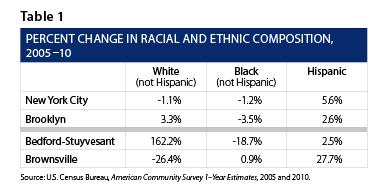
Public Housing
Public housing is often offered as a means of supporting low-income families and helping households maintain stability. The New York City Housing Authority (NYCHA) provides units for 403,357 residents in 178,895 apartments spread throughout the city.5 The average household in public housing earns $22,824 per year, and residents are required to pay no more than 30% of their household income on rent and utilities.6 Therefore, families in public housing are at much less risk of homelessness than the larger population, as they can receive rental adjustments based on changes in income. A household with a NYCHA placement would be loath to leave its residence; the application process for NYCHA is lengthy, and the waiting list for an apartment is currently 167,353 families.7
Brownsville has the largest concentration of public housing in the nation.8 The neighborhood is home to 18 developments, many of them high-rise buildings; at least 25% of the neighborhood’s population lives in NYCHA units. While the families in public housing face many burdens, and 38.5% live below the poverty line, the homeless families from Brownsville likely come from non-NYCHA housing.
Bedford-Stuyvesant is also home to a large number of public-housing complexes, including the Marcy Projects, the largest in the neighborhood, with 1,717 units and more than 4,000 residents. While fewer residents of Bed-Stuy live in public-housing projects than do their neighbors in Brownsville, the projects are still home to many of the neighborhood’s poor residents. Despite the gentrification occurring in Bedford-Stuyvesant, given the large swath of public housing, the neighborhood will likely continue to have a comparatively high poverty rate and a low median income. Additionally, those poor residents who do not live in subsidized housing have to compete with higher-income newcomers for increasingly expensive market-rate housing.
The significant number of housing projects in the two neighborhoods actually disguises a larger number of households experiencing rent-burden: well over half of residents in both Brownsville and Bedford-Stuyvesant pay more than 30% of
their income in rent. A calculation of the number of those households demonstrates that among 78.3% of renters in Bedford-Stuyvesant (those renters who do not live in public housing), 58.7% pay more than 30% of their income on rental costs. In Brownsville, 71.1% of the non-NYCHA renters experience rent burden, including 41.5% of households that pay more than 50% of their income on rent.
Table 2

xxx
Educational Attainment
An increase in the number of residents who have completed college is also a commonly used indicator of gentrification, as more-educated renters often have higher incomes.9 Additionally, a 2011 report from the Institute for Children, Poverty, and Homelessness concluded that those who gain a high school education or equivalent reduce their risk of homelessness and are better able to help their families remain stably housed.10 Measuring the levels of education, as well as fluctuations in attainment, helps explain why the two neighborhoods under consideration saw such large numbers of families entering the shelter system.
While many New York City neighborhoods have seen a general rise in the number of well-educated residents, Brownsville showed much lower gains or even declines in educational attainment. In 2005 nearly 30% of Brownsville residents over 25 years of age lacked a high school diploma. By 2010 this percentage had declined by only a small margin (see Table 2). Brownsville maintains one of the largest concentrations of individuals whose highest attainment is a diploma or GED; from 2005 to 2010 the number of high school graduates living in the area increased by 1.4%. Though that level of education can help decrease a family’s risk of homelessness, it is still often challenging for those who have not attended college to find employment when competing with so many residents citywide with higher levels of education.
Bedford-Stuyvesant, on the other hand, has seen increases in its residents’ levels of education. The number of residents who lacked a high school diploma dropped by nearly one-quarter between 2005 and 2010, to 23.6%. While this is still higher than in Brooklyn or New York City, it represents huge gains in educational attainment for the neighborhood. The largest change, and a major indicator of gentrification, came in the number of residents with college and advanced degrees. The number of residents who held bachelor’s degrees rose by 52.4%, and that with master’s degrees increased by 54.4%. While these levels are also lower than borough or city totals, the increases from 2005 to 2010 are much larger than in nearly every other neighborhood in New York City. In Bed-Stuy, new, better-educated residents are contributing to the increased costs of rents and pushing out poor residents in the process.
Median Income and Rental Costs
Increases in median incomes and rises in rents place those who are precariously housed and have lower incomes in even shakier positions. An influx of higher-income renters can help drive prices up more quickly, as demand for apartments rises. In both
Brownsville and Bed-Stuy, the average monthly rent has in-creased at approximately double the rate seen both in Brooklyn and citywide (see Table 3). Given that rising rental costs are likely to move in tandem with higher household incomes, one might expect that the matching trends seen in the two neighborhoods indicate a similar parallel in the earnings of local residents. As seen in Tables 4 and 5, this has not been the case.
Table 3
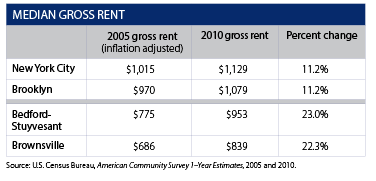
Median household income did indeed rise in Bed-Stuy and Brownsville, and, like the rise in rental costs, the growth from 2005 to 2010 outpaced the trends seen in the city at large. The misleading nature of this statistic is revealed, however, when only the incomes of renters are included. Among non-homeowners, the median income in Brownsville actually decreased over the five years in question, while the income of Bed-Stuy renters increased by nearly 5% (see Table 5). What we are seeing, therefore, is evidence of the divergent fortunes of Bed-Stuy and Brownsville, as well as the growing income inequality within each. That the median income for renters could still drop despite the arrival of wealthier homeowners shows how the middle class is disappearing from Brownsville despite growing in its neighbor.
Table 4
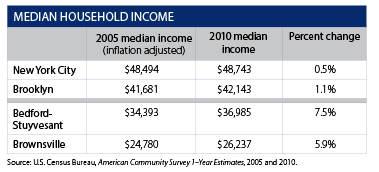
Table 5
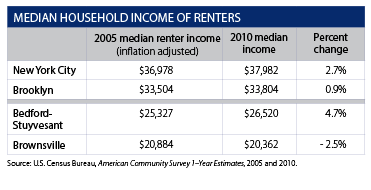
A Theory of Poverty Destabilization
Bedford-Stuyvesant and Brownsville are next-door neighborhoods, and both contribute a large number of families to the shelter system. While we do not know exactly what brings families to shelters, understanding the characteristics of the neighborhoods that contribute so highly to the homeless system is a step toward that knowledge. While Brownsville has seen few signs of prosperity—rising rental costs notwithstanding—Bedford-Stuyvesant has experienced the beginnings of gentrification. For the poor residents of Bed-Stuy, this has meant competition from higher-income families for increasingly expensive housing, which forces households to pay a larger share of their income on rental costs and makes it challenging for families to meet all of their needs. In Brownsville, the persistent poverty, low incomes, and poor educational attainment of its residents has caused many families to struggle financially, particularly those who are unable to secure placement in public housing.
Given the general west-to-east progression of gentrification in northern Brooklyn (with gentrification in Williamsburg, Park Slope, Clinton Hill, and Fort Greene), it is likely that low-income residents from Bed-Stuy are spilling over to Brownsville. This migration of the poorest of the neighborhood’s households in turn creates a competitive housing environment in Brownsville, where poor residents compete with each other for affordable housing that is in short supply. As poverty rates in the city rise, the difficulty of supporting low-income families increases. The housing safety net—including public housing and low-cost market-based rentals—can serve only a fixed number of households and is becoming increasingly limited, as competition for resources continues to grow.
As a result of this competition among low-income households, the poverty equilibrium—the ability of poor longtime neighborhood residents to get by on limited resources—is becoming destabilized. Poverty is becoming bifurcated, with a distinction between the poor and the poorest-of-the-poor. The poorest of the city’s residents now face competition not only from wealthier households but also from other families living in poverty. While competition for scarce resources has always existed, those in poverty once had enough government and community support to maintain the stability of their families. Today, while households at the higher end of the poverty threshold can “hang on” a little more easily and remain out of shelter, the poorest residents cannot summon the resources to remain stably housed. This multitiered system is destabilizing the structure of low-income neighborhoods and leading those already struggling to homelessness.
